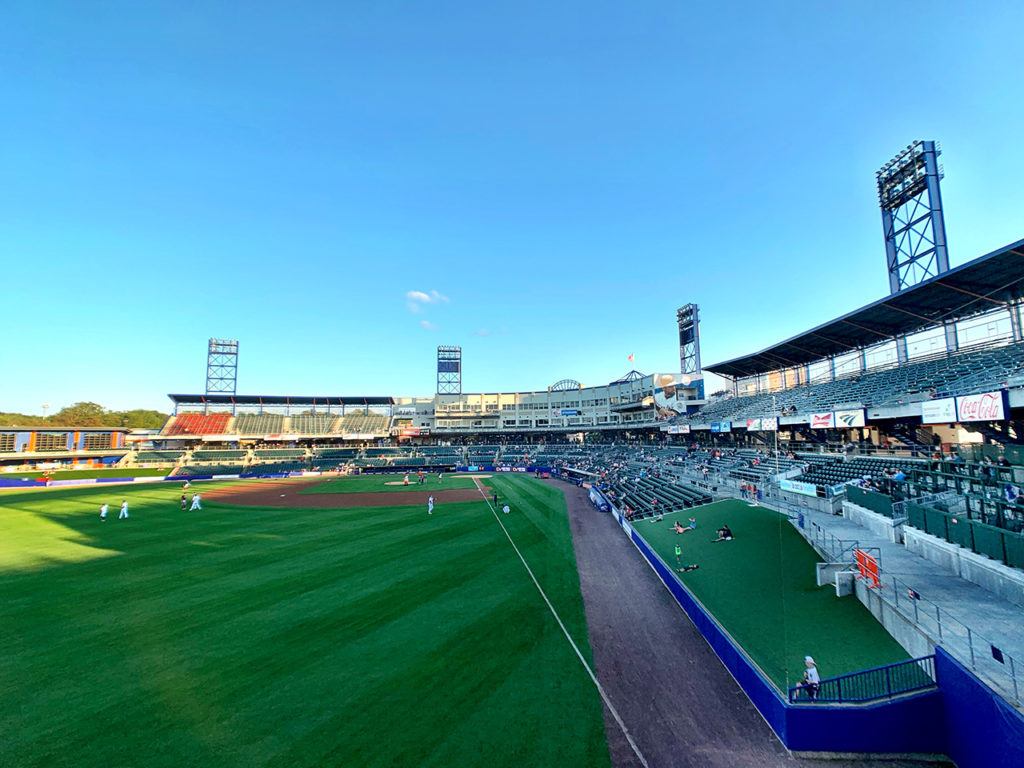
With the new Collective Bargaining Agreement (CBA) paving the way for MLB rule changes with proper notice, 2022 MiLB experimental rules will continue 2021’s trials and add two new rule changes to the Atlantic League.
We saw MiLB and MiLB Partner Leagues used as guinea pigs for 2021 experimental rules on a limited basis. The MLB line is that these experimental rules showed promise and deserve further study (though MLB’s Morgan Sword said in the Atlantic League, which tested the more extreme experimental rules. “it has just not been that big a deal“); more objective research showed a limited impact. The use of the most promising rules will be expanded to additional levels of play. So here are your 2022 MiLB experimental rules:
- Pitch clock: On-field timers will be used at all full-season affiliates to enforce regulations designed to create a crisp pace of play, with batters required to be ready to hit and pitchers required to deliver the pitch within allotted periods of time. With runners on base, pitchers will have additional allotted time for each pitch but will risk automatic baserunner advancement if a third pick-off attempt or step-off within the same plate appearance is made without recording an out. These rules were used in tandem in the Low-A West and in the Arizona Fall League in 2021 and led to a significant improvement in pace of play and a reduction in average game time of more than 20 minutes.
- Larger Bases: The size of first, second and third base will be increased from 15 inches square to 18 inches square at all full-season affiliates to reduce player injuries. Bigger bases were used in 2021 at the Triple-A level and in the Arizona Fall League, and were associated with a decrease in the severity of base-related injuries. In addition, the reduction in distance between bases led to a modest increase in the rate of successful stolen base attempts. More stolen bases, in theory, means more scoring.
- Ban on Shifts: In Double-A, High-A and Low-A, the defensive team must have a minimum of four players on the infield, with at least two infielders completely on either side of second base. These restrictions on defensive positioning are intended to allow infielders to better showcase their athleticism, to increase batting average on balls in play, and to restore a more traditional set of aesthetics and outcomes on batted balls.
- Automated Ball-Strike (“ABS,” or so-called “robo-umps”): In select games in Triple-A and in the Low-A Southeast, ABS technology will be used to call balls and strikes. ABS was used in the Atlantic League in 2019, and in select games in the Low-A Southeast and Arizona Fall League in 2021. In Triple-A West, umpires will call balls and strikes through May 15th, and the ABS system will be utilized in all games beginning May 17th. In Triple-A East, ABS will be used throughout the season in all games played in Charlotte. In both leagues, the ABS strike zone will approximate the strike zone called by high-level umpires. n Low-A Southeast, MLB will test a “Challenge” system in select games, in which umpires call balls and strikes, and the pitcher, catcher, and batter have an ability to appeal the umpire’s call to the ABS system. In Challenge Games, each team will receive three appeals. Successful appeals will be retained.
“Given the positive results of recent years, we are continuing to prioritize the kinds of experimental rules that many baseball fans routinely discuss and want to learn more about,” said Michael Hill, MLB’s Senior Vice President for On-Field Operations, via press release. “The testing throughout the Minors will provide us with more valuable feedback and data that can be taken into consideration.”
Additional rule changes will be tested in the Atlantic League this season:
Double-Hook Designated Hitter Adjustment: The double-hook designated hitter will be modified. In 2021, teams lost their designated hitter when they removed the starting pitcher from the game. However, in 2022, if the starter is able to complete at least five innings, the designated hitter will be allowed to remain in the lineup for the entirety of the game. This rule intends to place emphasis on longer outings by starting pitchers.
Dropped Pitch Rule: As in the second half of 2019, batters will be able to advance to first base on any pitch that is not caught in the air by the catcher, even with first base occupied by a runner. Those who get to first base safely will be awarded a hit. This rule will increase the importance of taking care of the baseball (e.g., pitching with command, receiving, and blocking pitches) and reward athletic players who are able to capitalize on wild pitches and passed balls.
RELATED STORIES: Per the numbers, 2021 MiLB rule changes didn’t really matter; Pitching-rubber shift part of 2021 Atlantic League experimental rules; MLB begins messing with MiLB rules; Atlantic League Reaction to ABS Technology Mixed; ABS Technology To Be Used in Spring Training on Limited Basis; New Tentative MLB/Umpire Deal Paves Way for Robo-Umps; Manfred: Automated Strike Zone Coming to Some MiLB Ballparks in 2020; Viola Criticizes Results of Atlantic League-MLB Partnership; Atlantic League Debuts Robo-Umps Across Circuit; Sky Does Not Fall; Atlantic League To Continue Robo-Ump Experiment for Rest of 2019 Season; Atlantic League, MLB Unveil Second-Half Rule Changes; Automated Ball-Strike System Used at Atlantic League All-Star Game; Atlantic League All-Star Game to Feature Automated Ball-Strike System; Atlantic League Tests Trackman System
